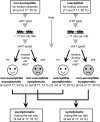Assessment of vestibulo-ocular reflex and its adaptation during stop-and-go car rides in motion sickness susceptible passengers
- PMID: 37097301
- PMCID: PMC10224860
- DOI: 10.1007/s00221-023-06619-4
Assessment of vestibulo-ocular reflex and its adaptation during stop-and-go car rides in motion sickness susceptible passengers
Abstract
Motion sickness is a physiological condition that negatively impacts a person's comfort and will be an emerging condition in autonomous vehicles without proper countermeasures. The vestibular system plays a key role in the origin of motion sickness. Understanding the susceptibility and (mal) adaptive mechanisms of the highly integrated vestibular system is a prerequisite for the development of countermeasures. We hypothesize a differential association between motion sickness and vestibular function in healthy individuals with and without susceptibility for motion sickness. We quantified vestibular function by measuring the high-frequency vestibulo-ocular reflex (VOR) using video head impulse testing (vHIT) in 17 healthy volunteers before and after a 11 min motion sickness-inducing naturalistic stop-and-go car ride on a test track (Dekra Test Oval, Klettwitz, Germany). The cohort was classified as motion sickness susceptible (n = 11) and non-susceptible (n = 6). Six (out of 11) susceptible participants developed nausea symptoms, while a total of nine participants were free of these symptoms. The VOR gain (1) did not differ significantly between participant groups with (n = 8) and without motion sickness symptoms (n = 9), (2) did not differ significantly in the factor time before and after the car ride, and showed no interaction between symptom groups and time, as indicated by a repeated measures ANOVA (F(1,15) = 2.19, p = 0.16. Bayesian inference confirmed that there was "anecdotal evidence" for equality of gain rather than difference across groups and time (BF10 < 0.77). Our results suggest that individual differences in VOR measures or adaptation to motion sickness provocative stimuli during naturalistic stop-and-go driving cannot predict motion sickness susceptibility or the likelihood of developing motion sickness.
Keywords: Adaptation; Motion sickness; Stop-and-go car ride; Vestibulo-ocular reflex; Video head impulse test.
© 2023. The Author(s).
Conflict of interest statement
E.S. is general manager and a shareholder of EyeSeeTec GmbH. C.R. was an employee of EyeSeeTec GmbH. A.B. and R.P.X. are employed by Volkswagen AG. M.G., T.S. and P.M. declare no competing conflicts of interest.
Figures



Similar articles
-
Video head impulse test and seasickness susceptibility.Exp Brain Res. 2025 Apr 16;243(5):119. doi: 10.1007/s00221-025-07078-9. Exp Brain Res. 2025. PMID: 40237844 Clinical Trial.
-
Higher Asymmetry Ratio and Refixation Saccades in Individuals with Motion Sickness.J Am Acad Audiol. 2018 Feb;29(2):175-186. doi: 10.3766/jaaa.16175. J Am Acad Audiol. 2018. PMID: 29401064
-
Head Impulse Test Paradigm and Suppression Head Impulse Test Paradigm in Individuals With and Without Motion Sickness.Am J Audiol. 2021 Sep 10;30(3):518-523. doi: 10.1044/2021_AJA-21-00009. Epub 2021 Jun 12. Am J Audiol. 2021. PMID: 34121426
-
Studies of the horizontal vestibulo-ocular reflex in spaceflight.Arch Otolaryngol Head Neck Surg. 1989 Aug;115(8):943-9. doi: 10.1001/archotol.1989.01860320053018. Arch Otolaryngol Head Neck Surg. 1989. PMID: 2665791 Review.
-
Video head impulse test: a review of the literature.Eur Arch Otorhinolaryngol. 2017 Mar;274(3):1215-1222. doi: 10.1007/s00405-016-4157-4. Epub 2016 Jun 21. Eur Arch Otorhinolaryngol. 2017. PMID: 27328962 Review.
Cited by
-
Three-dimensional characteristics of nystagmus induced by low frequency in semicircular canals of healthy young people.Front Neurosci. 2024 Jan 4;17:1321906. doi: 10.3389/fnins.2023.1321906. eCollection 2023. Front Neurosci. 2024. PMID: 38239831 Free PMC article.
-
Feeling unwell of passenger travel by small vehicles and associated risk factors in the North Shewa Zone, Oromiya, Ethiopia.BMC Public Health. 2024 Jun 24;24(1):1672. doi: 10.1186/s12889-024-19172-8. BMC Public Health. 2024. PMID: 38915024 Free PMC article.
-
Video head impulse test and seasickness susceptibility.Exp Brain Res. 2025 Apr 16;243(5):119. doi: 10.1007/s00221-025-07078-9. Exp Brain Res. 2025. PMID: 40237844 Clinical Trial.
References
-
- Braccesi C, Cianetti F. Motion sickness. Part I: development of a model for predicting motion sickness incidence. Int J Hum Fact Model Simul. 2011;2:163–187. doi: 10.1504/IJHFMS.2011.044492. - DOI
-
- Brietzke A, Pham Xuan R, Dettmann A, Bullinger AC. Influence of dynamic stimulation, visual perception and individual susceptibility to car sickness during controlled stop-and-go driving. Forsch Ingenieurwes. 2021;85:517–526. doi: 10.1007/s10010-021-00441-6. - DOI
MeSH terms
LinkOut - more resources
Full Text Sources
Medical
Research Materials
Miscellaneous

